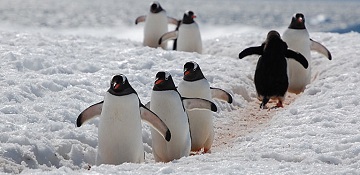400416-stayingwarm.jpg

Gentoo penguins in Antarctica. Credit: National Oceanic and Atmospheric Administration
Penguins may look cool, but they never seem to get cold. And recent research has provided some reasons: tiny holes in their feathers, and a special oil that acts as a sort of antifreeze.Researchers compared the feathers of two types of penguins — the gentoo, which lives in Antarctica, and the magellanic, which lives in the warmer climate of South America.
The gentoo is the third-largest of all Antarctic penguins. An average adult is about two-and-a-half feet tall, and weighs about 12 pounds. It spends a lot of time hunting for food in the frigid Antarctic waters. And when it gets out of the water, the air can be even colder. Yet the gentoo’s feathers remain ice free.
To find out why, the researchers looked at gentoo and magellanic feathers with a scanning electron microscope. And they found that gentoo feathers are pockmarked with tiny pores. The pores trap air, which is warmed by the penguin’s body.
The researchers also found that gentoo feathers are coated with a special oil produced by a gland near the bird’s tail. The penguins work the oil into their feathers, which causes water to form small, round beads. There’s little contact between the beads and the feathers, so there’s not much surface to transmit cold from the water to the penguins. And the oil helps ensure that the water drips away before it has time to freeze. The researchers suggest that their work could lead to new techniques for keeping ice off the wings of airplanes — protecting flying “birds” with the help of flightless ones.

